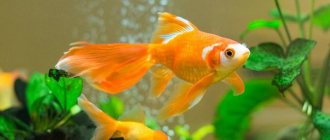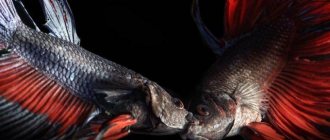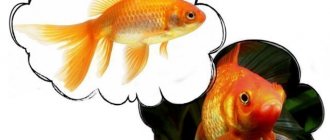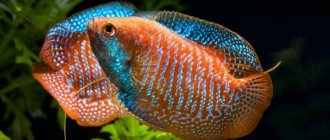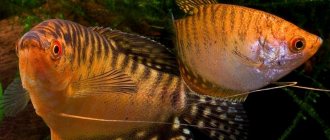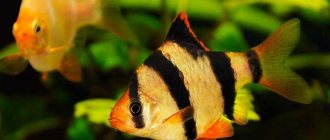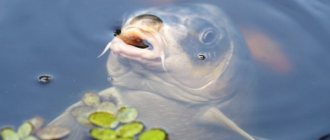Goldfish are the most popular inhabitants of aquariums. Beginner aquarists, as a rule, give these graceful beauties a priority role when choosing aquatic pets. However, further settlement of the water area must be carried out taking into account the interests of goldfish and focusing on the possibility of comfortable living together in one container. A lot of research and observations carried out since the Middle Ages make it possible to select neighbors for these beautiful creatures with whom they can live happily.
The history of the appearance of goldfish in aquariums
The ancestor of the goldfish is considered to be the silver crucian carp, which became the source material for the work of breeders. The goldfish (Carassius auratus) was developed in China between the 3rd and 5th centuries AD. Later it came to Korea and Japan.
It was brought to Russia in the middle of the 17th century. At that time, this species was considered very rare. Now, due to its unpretentiousness, it has become a frequent guest of many aquariums.
With whom sharing is contraindicated?
It is better not to mix goldfish with the following types of fish, as this may end badly for them.
Barbs
Barb hunters will not leave the veil-like fins of goldfish alone until they turn into stubs. Therefore, cohabitation of these fish is contraindicated.
It is strictly forbidden to keep goldfish with barbs.
Guppy
Guppies are too tiny aquarium inhabitants, so they will definitely become prey for golden goblets. Even by young individuals, the lush tails of guppies will certainly be plucked. In addition, these fish prefer completely different temperature conditions.
Angelfish
Angelfish, which belong to the aggressive breeds of fish, will not give the phlegmatic goldfish rest; they will chase them, biting their tail and fins. In addition, these aquarium inhabitants are accustomed to different temperature environments. Therefore, the proximity of these fish is unacceptable.
Aquarium fish angelfish
African cichlids
Guppy fish
African cichlids
African cichlids are ardent defenders of territory; they will not give rest to the golden inhabitants and will constantly try to attack them in order to drive them away from their territory. Therefore, such cohabitation is excluded.
American cichlids
Any species of cichlids are large fish, native to tropical latitudes, preferring warm southern waters. Goldfish are descendants of common crucian carp that live in temperate climates. Absolutely different temperature conditions do not allow keeping these representatives of aquafauna in the same dwelling. In addition, American cichlids are aggressive predators, for which Carassius auratus will be easy prey.
American cichlids are undesirable neighbors for goldfish
All representatives of the cichlid family are very aggressive predators. Astronotus is particularly hostile, for which golden carp will become a tasty prey. Therefore, goldfish cannot be kept with any representative of this family, even the smallest.
Swordtails
These sharp-tailed aquarium inhabitants have a habit of biting the fins of their neighbors, so cohabitation with goldfish will have an unfavorable effect on the latter.
Swordfish
Discus
Discus
Discus fish are heat-loving creatures; they are comfortable swimming in water with a temperature of 30-32 degrees. Goldfish will simply “cook” at such temperatures, so cohabitation of these species is impossible.
Appearance and character of the goldfish
The adult is red-orange in color with a metallic tint.
Young fish are usually greenish-turquoise. The color changes to adult color at one year of age.
All fish with simple tails have dorsal and anal fins with long bases. The caudal fin is straight, forked. The lateral line is pronounced.
Individuals with double tails (water eyes, celestial eyes, telescopes, etc.) have forked caudal and anal fins. The dorsal fin may be absent.
Almost all goldfish are slow, calm and often like to hang out in one place.
Examples of Negative Neighborhoods
Under no circumstances should phlegmatic goldfish be housed with the following types of fish:
- Barbs (except cherry ones) are too fussy and often aggressive;
- Angelfish - they risk losing their beautiful fins, and they themselves tend to stir up conflicts;
- Discus fish are very demanding on water quality and do not tolerate cold water;
- American and African cichlids - can cause serious damage to golden ones;
- Poeciliids - having veil fins - will quickly lose them, the offspring will become a snack for their golden neighbors, and some species are too playful;
- Tetras – due to their small size they are at risk of being eaten;
- Labyrinthine - show aggressiveness.
Keeping and caring for goldfish
Before buying a goldfish, it is useful to know how to keep and how to care for your pet: what the aquarium should be like, the temperature of the water, its aeration and filtration, how many goldfish you can keep, what to feed, and much more.
Let's look at the main points:
1. Volume of the aquarium. An aquarium for goldfish should be at least 150 liters and rectangular in shape. Fish cannot be kept in a round aquarium. This is explained by the fact that the concave walls of such an aquarium distort the perception of the fish, creating severe stress. And constant stress can lead to the death of your pet.
In addition, concave walls cannot be properly cleaned of algae deposits, and your aquarium will have an unsightly appearance.
Additional requirements for the aquarium:
- short;
- wide;
— the water level should not exceed 30 centimeters;
— there must be a system of aeration, filtration and heating of water.
It is necessary to select an aquarium at the rate of 50 liters of water per fish. It is recommended to keep no more than 2 individuals in one aquarium.
2. Water for goldfish. It is very important to monitor the temperature and water changes. The established opinion about the cold resistance of these fish and, as a consequence, keeping them at temperatures from 18 to 20℃ is only partly true.
At this temperature, only unpretentious species - comet and shubunkin - feel great. For other varieties, the temperature should be 23 - 26℃.
Intensive metabolism contributes to the formation of large amounts of waste. In addition to filtering, it is necessary to replace 1/10 - 1/5 of the water with new water every week. The added water must be settled (without chlorine) and have the same temperature as the aquarium water.
Instead of settling, you can use special products to turn tap water into something suitable for fish. They can be bought at pet stores.
A prerequisite is a noticeable flow and a sufficient amount of oxygen.
3. Soil, vegetation, shelters. The aquarium should be planted with large plants with a strong root system, but soft leaves - elodea, hornwort and others.
Since these fish look for food at the bottom, it is recommended to use coarse sand as a substrate.
Goldfish love open spaces, so a lot of hiding places are not required (plants will play their role).
What fish do they get along with?
There are breeds with which goldfish get along the easiest.
Other breeds of goldfish
A species aquarium is the best solution for keeping Carassius auratus.
All breeds of goldfish are absolutely compatible in all respects: temperature, temperament and nutrition. However, nuances are taken into account here. It is better not to place short-bodied individuals in the same container with long-bodied ones due to their different characters. Long-bodied scrofulas are, as a rule, somewhat faster than long-tailed beauties.
It is not recommended to place long-bodied and short-bodied goldfish in the same aquarium.
Also, different-sex fish of different breeds cannot be placed in the same aquarium. Since all goldfish are bred through selection from silver crucian carp, various subspecies will begin to interbreed with each other, thereby reproducing mutating offspring - hybrids, in which species characteristics will be lost.
Ultimately, such a mutation will lead to the degeneration of the species and the transformation of scrofula back into crucian carp.
Koi carp
A friendly neighborhood would be the cohabitation of goldfish and koi carp. Both of them belong to the carp family, only the ancestor of which is the carp, and the ancestor of Carassius auratus is the crucian carp. Therefore, when they cohabit, crossing cannot occur.
Koi carps come from the same family as goldfish.
Koi carp are often called goldfish because of their golden, bright color. Calm, even-tempered koi have a similar personality to goldfish and cannot harm them. Even their habits are the same - they also prefer to dig in the ground, raising mud from it.
There is only one minus. Koi carps grow up to 70 cm and are best placed in a pond. Purchasing an aquarium of the appropriate size is problematic, given that there must be at least 5 liters of water per 1 cm of body. Although many scrofula live well in pond water.
Corridors
Corydoras catfish will also serve as excellent peaceful neighbors for goldfish. Their temperature regimes are completely the same. Both prefer cool water no higher than 25 degrees.
Corydoras are excellent neighbors for goldfish
Corydoras live in groups, lead a bottom lifestyle, collecting leftover food and waste from the bottom of the aquarium, of which Carassius auratus leaves a lot.
The only drawback in their neighborhood is that Corydoras are very slow, which may not please the main owner of the aquarium.
Tarakatums
Corydoras' cousins, the Tarakatum catfish, also get along well with goldfish in the same area. These representatives of the underwater world lead completely different lifestyles, so they practically do not overlap in the aquarium.
Tarakatums can live peacefully with goldfish
Feeding goldfish in an aquarium
How many times to feed and what to feed are not as simple questions as they might seem at first glance. Goldfish need varied and plentiful (but not excessive!) feeding.
The basis of the diet can be dry food specially developed for them. You can also feed small insects (for example, fruit flies), live (bloodworms) and vegetable (dry vegetable fish food, blanched watercress, lettuce and spinach) foods. When feeding bloodworms, overfeeding should be avoided.
Feed 2 – 3 times a day in small portions.
Differences between male and female goldfish
If you decide to start breeding goldfish, then you should be able to distinguish between their sexes.
The male goldfish is more active and slender. Before spawning, notches appear on the front rays of the pectoral fins and white marks appear on the gill covers (not to be confused with the disease ichthyophthyriasis, in which the fish becomes lethargic).
The female has a thicker and rounder body. The anus is convex (before spawning it may protrude slightly from the body). The anal fin is denser.
As the eggs develop, one side may bulge, causing the female to appear asymmetrical.
Mollies maintenance, feeding compatibility spawning care description
Popular types of MOLLINESIA
Breeding Mollies
Molly fry
Sex differences:
description
Characteristics of MOLLINESIA
MOLLYNSIA COMPATIBILITY
Mollies are considered one of the most beautiful fish, which is why they are desirable pets for many aquarists. They get along well with swordtails. Although the “swords” have a rather restless character, they chase platies very rarely.
Only if there are no female swordtails in the flock, the “guys” will try to pester the molly, but, as you understand, to no avail. Also keep in mind that in tight spaces there may be turf battles, so the fish should have plenty of space.
The compatibility of mollies with guppies is almost ideal. Both species are viviparous, live in warm, brackish water, love sunlight and dense vegetation. If your plans include breeding, then before giving birth the fish should be separated from each other, and after the offspring appear, the females should be removed, since they sometimes do not mind eating their own fry.
In general, mollies can be kept together with:
- All types of poeciliids and catfish,
- Rainbows,
- Tetrami,
- gourami,
- Labeo.
MOLLINESIA VIDEO
Breeding goldfish
If you have fish of different sexes in your aquarium, you can try breeding them. First, let's find out how goldfish reproduce.
The optimal period for reproduction is the end of spring. At this time, the behavior of sexually mature fish, ready for spawning, changes. The male will catch up with the female, positioning himself slightly lower and behind her. In addition, he will press her against the walls of the aquarium or against plants, forcing her to start spawning.
As soon as you notice these changes, the future parents should be transplanted into a large (up to 80 liters) aquarium with good aeration, installed in a sunny place and planted with pinnate plants.
The characteristics of the water in the spawning aquarium are as follows:
— fresh, settled or specially prepared;
— temperature from 25 to 26℃;
— hardness (dH) of at least 80 (can be determined using rapid tests sold in pet stores).
At this time, producers need a nutritious and varied diet.
Goldfish usually begin to spawn early in the morning. The duration of spawning varies, but, as a rule, no more than 3 hours. On average, a large female can produce up to 3 thousand eggs. Freshly laid eggs are small (up to 1 mm), slightly yellowish.
Goldfish often eat their eggs, so after spawning the parents are transferred to a common aquarium. The water in the spawning area is disinfected with a weak solution of trypaflavin and strongly aerated.
The larvae hatch in 4–5 days and become fry in 2–3 days.
Photo 1. Goldfish larva
Photo 2. Goldfish fry
The fry are very sensitive to changes in environmental conditions, especially temperature fluctuations.
The fry need to be fed a lot. They are fed with fine dry food, “live dust”, egg yolk, steamed and washed crushed dry daphnia.
As they mature, the fry are separated to prevent cannibalism.
Rules for compatibility of discus fish with other fish
Discus fish are peaceful aquarium fish, slow and timid. They can get along with the same fish of similar sizes, but there are a number of reasons why it is undesirable to house them with other types of fish. It would seem that, as representatives of the Cichlid family, they should have a hardy body and strong immunity, but keeping them with other fish is still an open question.
Why is it not recommended to place discus fish in a community aquarium?
Who can be kept with discus fish?
Goldfish diseases and their treatment
Signs of a pet's health are a good appetite, even and bright color, mobility and a healthy shine to the scales. Any change in these parameters should alert the owner.
Goldfish diseases are divided into non-contagious and contagious. Let's look at both types in more detail.
Non-communicable diseases
These include injury, overeating, exposure to external factors, etc. Let's list some of them.
Injuries: most often these are wounds. Causes of injury may include improper transportation, aggression from other fish, soil, or decorative elements with sharp edges.
Externally they can manifest themselves in the form of loss of scales, damage to the skin, abrasions, open wounds, rupture of fins or their loss, loss of organs (for example, eyes). Severe damage can result in death.
If an injured fish is found, the latter is transplanted into a separate small container (preferably without soil) with water parameters corresponding to the main aquarium.
A little methylene blue is added to the water in the quarantine aquarium to prevent fungal diseases (if the victim cannot be removed, methylene blue is added to the general aquarium). The fish itself is treated with agents that accelerate tissue regeneration (can be purchased at a pet store).
You can transplant it into a common aquarium after complete recovery and healing of the wound.
Obesity: occurs due to overfeeding. In the early stages it is not noticeable. Manifested by decreased activity and protrusion of the abdomen. Appetite remains. Obesity is an irreversible process and leads to the death of fish.
As a preventive measure, moderate and varied feeding can be recommended.
Stress: can be caused by various factors (transportation, illness, aggression of other fish, treatment, etc.). It can be temporary (for example, transplanting into a new aquarium) or permanent (keeping in poor conditions). Constant stress leads to decreased immunity and frequent illnesses.
Treatment of stress involves minimizing the factors that cause it. You can also use drugs that reduce its level.
Contagious diseases
Can be transmitted from sick fish to healthy ones
There are infectious and parasitic. Let's look at some of them.
Infectious diseases
Mycobacteriosis (fish tuberculosis): a common and dangerous disease.
Caused by the bacterium Mycobacterium. Goldfish are the most susceptible to this disease.
Sick fish are lethargic, apathetic, and constantly lie on the bottom. Appetite is reduced. The caudal fin is lowered. Over time, exhaustion, bulging eyes and skeletal deformation occur. Dropsy and ruffling of scales also occur.
The disease is successfully treated only in the early stages with antibiotics (ciprofloxacin, nifurpirinol). In advanced cases, it is advisable to kill the fish. Sick fish are quarantined, and the main aquarium is completely sanitized (including soil, equipment and plants).
“Rubella”: a dangerous disease of goldfish caused by bacteria of the genus Aeromonas and Pseudomonas (in the bacterial form) or a virus of the Rhabdoviridae family (in the viral form). It often occurs at lightning speed.
Symptoms of the disease are as follows: hemorrhages on the body and fins; blood-red ulcers with a white border; boils, pimples and other growths on the head; dropsy; bulging eyes and ruffled scales. Pathologies of internal organs also develop.
The disease is treated only in the initial stages (with the exception of dropsy and ruffling of scales). It is advisable to use broad-spectrum antibiotics (nifurpirinol, ciprofloxacin, enrofloxacin, etc.).
Important!
The effectiveness of treatment can only be confirmed or refuted in the laboratory.
Rots: distinguish between mouth rot and fin rot. The prerequisites for the occurrence of both diseases can be improper conditions for keeping goldfish (crowding, changes in water characteristics) and their stress.
Mouth rot is caused by the bacterium Flexibacter columnaris. This is a very dangerous and contagious disease.
First, whitish marks appear on the fish in the mouth area, on the head or body. The fish becomes lethargic and spends a lot of time at the bottom, pressing its fins. Soon the foci of pathology become covered with cotton wool-like whitish formations. In the final stages, the muscles are affected and the fish dies.
The disease can be successfully treated only in the early stages. The use of antibiotics (nifurpirinol, furazolidone, tetracycline) and frequent changes of water are recommended.
Fin rot is caused by Pseudomonas bacteria. The disease is not dangerous and does not occur if properly maintained.
Symptoms of the disease are as follows: whitish or bluish cloudiness and dissection of the edges of the fins. Then erosion and necrosis of the fins occur. Eventually the fins die, forming ulcers at the base, resulting in the death of the fish.
Treatment can be carried out in the main or quarantine aquarium. In the main aquarium (after removing invertebrates) use malachite green with copper sulfate or preparations with formaldehyde, acriflavine or trypaflavin.
If treatment occurs in a quarantine aquarium, then drugs with methylene blue and acriflavine are used.
In severe cases or when the disease is advanced, the fish are quarantined and treated with antibiotics (nifurpirinol, ciprofloxacin, enrofloxacin).
With proper treatment, fin regeneration occurs.
Parasitic diseases
The causes are protozoa, parasitic worms or parasitic crustaceans.
Ichthyophthyriosis: the most common disease caused by the ciliate Ichthyophthirius multifiliis. Whitish tubercles appear on a sick fish. The fish shows restlessness, periodically itching against the ground, plants and decor.
As the disease progresses, the number of rashes increases, the fish becomes lethargic, the appetite often disappears, and the fins are dissected. Subsequently, the fish lies on the bottom and the skin may peel off.
The effectiveness of treatment for the disease depends on the stage at which it was detected. The following medications can be used in the main aquarium: “Super Ick Cure” in liquid form (contains malachite green and povidone), “ContraIck”, “Costapur”. They must be used according to the instructions.
For the entire treatment period, the water temperature is raised by 1 - 2℃ (but not higher than 28℃). It is advisable to combine it with frequent water changes (with mandatory soil cleaning to remove cysts).
Prevention consists of quarantining new fish and maintaining the best conditions for existing ones.
Hydrodactylosis: a dangerous disease caused by the parasitic worm Gyrodactylus sp.
Symptoms: the fish begins to sway, freeze in place, and matte areas appear on the body. As the disease progresses, the fish itches intensely on the ground. plants and decor. The matte areas grow and the fish loses its appetite.
Treatment consists of using copper sulfate (5 ml per 25 liters of water or the drug “General Cure” according to the instructions), a mixture of malachite green and formalin along with the addition of table salt (1 tablespoon per 10 liters).
We have not covered all the diseases of goldfish. More detailed information can be found on specialized websites about fish diseases.
Types of aquarium swordtails
Most often on sale you can find such types of swordtails as black and red, as well as their combinations. In fact, there are many more of them.
If several species live in the aquarium, then the fry can turn out to be the most unusual colors. Unfortunately, the interesting result obtained cannot be consolidated.
The following types of swordtails are distinguished:
- Black with blue or green tint. It reproduces poorly, as health problems arise due to an excess of dark pigment.
- Red is uniformly colored orange in varying degrees of intensity.
- The brindle color is a combination of red and black, with males always having a dark tail.
- Mountain color is yellow with a cream tint. These fish have clearly visible spots and stripes of lighter colors.
- Iridescent is a combination of orange, gray and green colors combined with reddish stripes along the entire body.
- Calico color is tri-color. The base is white, with large spots of black and red colors randomly located on it.
- The Bulgarian White is an albino, the fish is almost transparent, the skeleton and internal organs are clearly visible.
- The lemon shade is albino with a greenish tint. This variety is especially difficult in breeding work, since the offspring do not always inherit the characteristic characteristics of their parents.
- Green is a combination of two shades - olive and brown, which complement the light and red stripes.
Most often, it is the red and black varieties that are on sale, but if you wish, you can buy all the others.
Colors and types of goldfish
They are very different and depend on the species.
Types of goldfish
There are two groups of goldfish - those with single tails and those with double tails.
Goldfish with simple tails
- Comet
It has an elongated, equally convex body shape. A distinctive feature is the deeply cut forked tail.
The color varies, but the most common is red-orange or lemon yellow. Loves large spaces. It is advisable to keep it in open water.
- Nymph
Nymph. Similar in shape to the veiltail.
- Shubunkin
The body is short and rounded. The color depends on the breed and structure of the scales.
A common combination is black, purple, azure and brown colors against a background of pearl or matte scales. The tail is rounded.
Goldfish with double tails
- Water eyes
It got its name because of the large bubbles of liquid on the sides of the head. The body is ovoid, the dorsal surface is straight.
The color is usually brick with a metallic sheen. There is no dorsal fin, the caudal and anal fins are paired.
It is better to keep this species separately and not use decor and soil with sharp corners.
- Heavenly Eye (Stargazer)
The eyes are directed upward due to the fleshy growths around them. The eyes assume their final position several months after hatching.
The caudal fin is straight and is a continuation of the back. It is better to keep the species in a home aquarium separately from other fish.
- Lionhead (Ranchu)
The body is short, egg-shaped, without a dorsal fin. The head bears a massive growth. The tail is held rigidly, without flowing downwards. Keep only in a home aquarium.
- Telescope
Has an ovoid body. The color is always black. Eyes can be regular or protruding.
The dorsal fin is located high, the anal fin is paired. The tail has a straight upper angle and is folded.
- Little Red Riding Hood (Oranda)
Shorter than other artificially bred goldfish. The color is different. The head bears a growth, but smaller than that of the lion's head. The dorsal fin is high. Caudal, anal - paired, free. Keep in an aquarium with non-aggressive fish.
- Pearl
The body is round and short. The color varies depending on the structure of the scales and its shade. The shape resembles a fantail, but has a different scale structure (the convex center of each scale is white or pearlescent).
The dorsal fin is located high. Caudal and anal fins are paired. Keep in an indoor aquarium.
- Pompon
The color usually has a metallic or pearly sheen. It is similar in appearance to a lionhead, but instead of a growth, this breed has nostrils that grow, forming two “pompons”, which in some individuals can hang down the sides of the mouth.
The original species does not have a dorsal fin (later forms have it). Keep in a separate aquarium with high-quality water.
- Veiltail
The body is relatively high. The color varies depending on the structure of the scales.
The caudal and anal fins are doubled and fall down. The pectoral fins are very developed. Eyes can be normal or telescopic. Suitable for open water bodies without detritus on the bottom.
Description of swordtails
The swordtail fish is one of the most popular inhabitants of aquariums.
Pets come in different colors, are unpretentious in keeping, rarely get sick and get along well with a large number of fish. The description of the swordtail is quite interesting. This is a small fish, its size is no more than 6 cm in length. They have an elongated body, flattened on the sides.
The tail of males has a characteristic feature - the fin bifurcates, its lower part becomes much longer than the upper and takes on a pointed shape. Because of this, the fish got its name - swordtail.
The color palette is very diverse, but most often there are representatives of red and black shades, as well as their combinations.
So, how to properly keep such fish, do they get along well with other inhabitants of the aquarium and do they often get sick?
Price for goldfish (in rubles)
Depending on the type purchased, the cost of one fish can range from 130 to 990 rubles.
This is interesting!
Surely many have wondered how do goldfish sleep?
It is possible to answer it. if you watch your pets at night or early in the morning (it’s better not to turn on the light in the aquarium, but to use an indoor one). You can see fish lying on the bottom or hovering in the bottom layer, slowly moving their fins and gill covers. This is exactly how they sleep.
Choosing aquarium neighbors for angelfish
Angelfish are peaceful aquarium fish that are called "angelfish" in some countries. As members of the Cichlid family, they still have a predatory instinct. Is it possible for angelfish to be compatible with other fish? This is a controversial issue, since even schematically acceptable compatibility can end disastrously for any aquarium fish. If you raise angelfish with other fish, starting from a young age, then in the future they will get along.
The main rule is not to place them with predatory, fast and aggressive fish and those that are smaller in size. Whoever fits into the mouth will be eaten by the scalar. The compatibility of these hydrobionts with: corydoras catfish, pseudotropheus, zebrafish, platies, labeos, tetras has been proven. We recommend that you familiarize yourself with the species compatibility table, which does not guarantee peaceful settlement in the same aquarium, but gives an idea of who angelfish usually get along with.
Also, keeping this fish is acceptable with those who will ignore its bright appearance and not fray its fins. The first time after introducing the fish into the tank, monitor their behavior. If quarrels, fights, or other forms of rivalry arise, move your roommates away immediately. Consider purchasing an additional tank.
